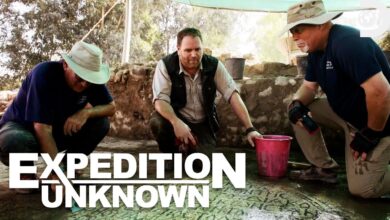Missing Sub: Former Titan passenger ‘couldn’t get comfortable with design’
Missing Sub: Former Titan passenger 'couldn't get comfortable with design'

I host the television program on Discovery Channel called Expedition Unknown, and we were thinking about the idea of making a special on Titanic. So, we went up to Ocean Gate’s headquarters in Everett, Washington in 2021. This was just before they were going to take their first group of passengers down to Titanic, and we went out with Stockton, the CEO, who is piloting Titan on this current mission as well. We joined Stockton for a shakedown dive on the sub, taking it out, putting it through its paces there in Puget Sound, and seeing how Titan performed, thinking about whether it would be a good fit for us to film for a show.
It’s a really striking submarine, as you’ll see in the stock footage of it here. It’s a very novel design—it doesn’t look like any other submersible that has gone down to Titanic before. A lot of that has to do with how it’s made. It’s made of a carbon fiber hull, as opposed to having a steel or titanium hull. And because it’s carbon fiber, it can be made much larger. So it’s actually quite a large submarine, capable of holding five people, as opposed to most of the subs that go down to Titanic, which only hold two or three. So, it’s actually quite spacious inside, as these kinds of subs go. As I said, it has a very unique design. It’s certainly a striking craft when you see it.
Yeah, Josh, you use words like “novel” and “unique” when it comes to its design. Ocean Gate itself, when you look at its website, talks about being at the forefront of innovation. In fact, it’s so innovative, it’s ahead of regulation. You know, regulation can’t keep up with its innovation. But was it safe? Did you get the feeling that it was safe? Did you talk to those that operated it about the safety measures involved and the kind of risks involved? Tell us a bit about that.
Yeah, look, this is one of the really challenging things about a vehicle like this: there is almost nothing to benchmark it against. There is no other vehicle like Titan anywhere in the world. It is a one-off. So evaluating risk for a craft like this is really difficult. We know that carbon fiber is extremely strong—it’s what’s used to build the Boeing Dreamliner or the Airbus A350. It is a miracle product in a lot of ways; it can be 10 times stronger than steel. But there are real questions about carbon fiber in terms of its fatigue—how does it perform at these kinds of pressures and in these cold temperatures after multiple cycles? It’s something that’s hard to evaluate. And so, risk is a very difficult thing to evaluate when it comes to Titan.
For us, on the dives that we did, I would say that some of the systems on board performed very well, and some of them didn’t perform well at all. We had issues with thrusters, we had issues with computer control aboard. But of course, this was a test designed to get Titan up and running for the voyages it was going to make a few months later. Those kinds of things aren’t uncommon on a test dive. Having said that, ultimately, I decided to back off of our project because I just couldn’t get comfortable with the design of Titan. There was so little data available about managing that risk, and really, what it looked like if this sub went up and down as many times as it was going to.
Remind me how long ago that was, because Ocean Gate and the number of dives it’s made since you were there on that sort of maiden shakedown dive, as you call it, it seems that safety wasn’t a concern for those going on those trips. There are waivers involved, and everybody’s well aware of the risk. The mention of death is apparently on the first page of the waiver—it’s mentioned three times.
Yeah, this was in 2021. That was at the beginning of its real maiden season of bringing passengers out for the first time. Look, it is described in those waivers as an experimental craft, and I think it is truly experimental in a very real sense of the word. This is not like boarding a commercial flight on a new airplane. This is like being a test pilot on a plane that has never flown before. There’s a totally different category of risk with a vehicle like this. I do think the passengers are made aware of a lot of those risks. But again, there are just a huge number of unknowns with a submersible like this.
There are elements of Titan where there are real redundancies. There are a lot of ways to drop weights, for instance, on Titan and bring it back to the surface. There are four different systems on board to drop weights. There’s a computer-controlled system that can vent water in or out of ballast chambers to help it rise up in the ocean. There’s a manual valve in Titan to take air and add it to bladders on the outside of the sub to bring it up. There’s a hydraulic-controlled system that can drop weights off the bottom. In fact, the entire skid assembly on the bottom of Titan can be dropped using a hydraulic lever, which takes a huge amount of weight off the sub to bring it to the surface. Those sorts of things were baked into the design of Titan to make it more safe. But there are other elements of its design that are more challenging.
You know, it cannot be opened from the inside. There is no top-side hatch on Titan because of the way the carbon fiber hull is built. And so, you have these trade-offs: an innovative, novel design, but it comes with a lot of mysteries. In terms of how it’s going to perform over time, yeah, it is a real mystery at the moment, while those search and rescue teams try to find it.
That’s really interesting information in terms of the security measures on board the sub, that if something goes wrong, like you said, you’ve just talked us through a whole raft of things that the crew on board can do. In light of that, what do you think has happened? What could have gone wrong in terms of, you know, it’s not floated to the surface? What are the kinds of things that could have gone awry down there?
You know, it’s tough to speculate about this. I think, in some ways, there are only a handful of categories of things that could go wrong. One of the real challenges here is communication. It’s very hard to communicate with untethered subs like this from the surface anyway, but the fact that Titan lost communication on its way down to Titanic, and that they have not received communication since then, would indicate that something went wrong with its systems.
Now, it was well off the bottom when that communication was lost. So, using those multiple redundancies of weight-drop systems, Titan should have returned to the surface, right? And so, the fact that that hasn’t happened opens up this whole other question of what these other possibilities could be. Look, certainly one of those possibilities is a hull failure that kind of speaks to the carbon fiber design of Titan, and also a concern in all submersibles. Electrical fires, computer failures, things like that.
I have to say, I think we’re still in the time period here—though this time period is closing—where I think we should remain hopeful. We’ve got five people aboard this sub, we have a young man aboard this sub, and all of these new assets are now rushing out to the North Atlantic to aid in this search. And so, I think that, you know, we should remain hopeful for a positive outcome for this, which is what everybody here wants, obviously. We’re going to know more about that, I think, in the next day or so.
Josh, what are the big questions being asked by everyone who follows this story? Why do this? Given this incident—of course, we don’t know the outcome of it yet, and it’s not looking good—but like you said, we cling to hope. Do you think this is the end of this kind of expedition involving this kind of submersible? Who’s going to want to get into one of these ever again? And again, it comes back to that question: why do you want to do this? You’re someone who does this. Talk us through that.
Well, look, you know, this is a big question, and it’s something that, especially on social media, people seem to be talking about a lot. I think there’s actually been a lot of quite, you know, impassioned comments on social media. I’ve been reading from people who just say, “Why? Why should anybody ever attempt something like this?” Look, I think first of all, it’s important to remember that Titanic has fascinated the world since the night that she sank. You know, there is an incredible allure to this shipwreck and indeed to all shipwrecks. I think because they are time capsules, and they are transportative. They bring us to a moment in our own past—in the case of Titanic, to a gilded age in a lot of ways. And so they hold a real fascination for people, both just as a matter of interest, but also to historians and to scientists.
And so I think that, you know, the people aboard Titan, I think, were there because they had a real passion and a real interest for Titanic. And as someone who manages risk for a living and who does a lot of risky things, look, it takes a lot of courage and determination to go on a voyage like this in a submarine down to these kinds of depths. And so I think there should be a lot of admiration for the people aboard Titan, because I think this is something that speaks to their passion. You know, there are people who climb Everest, there are people who parachute, and many of us would say, “Why do those things?” And those people would say, “Because it’s something that speaks to








